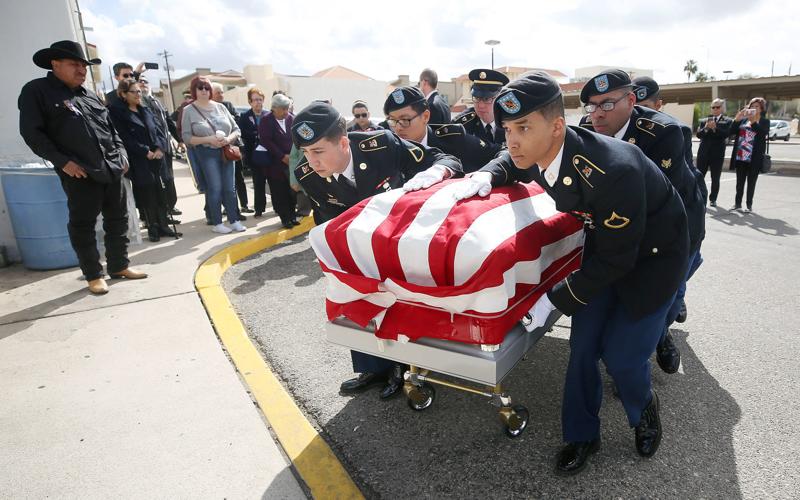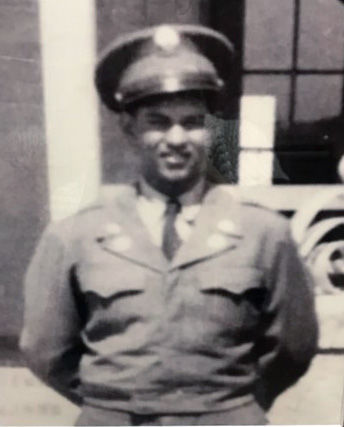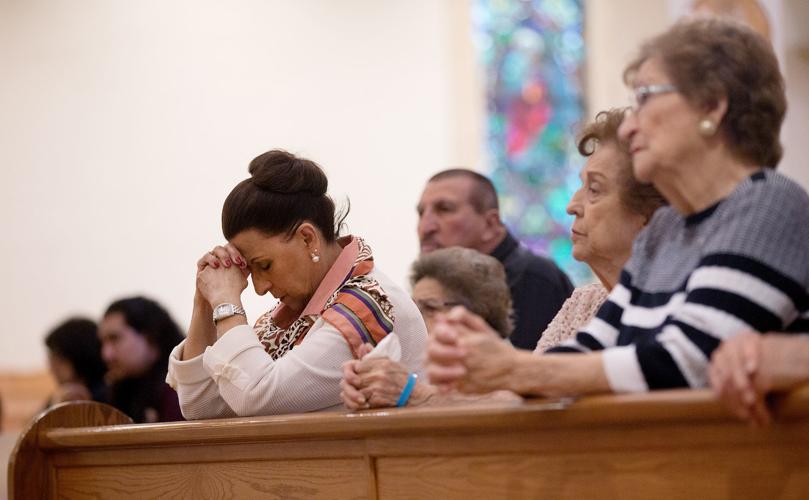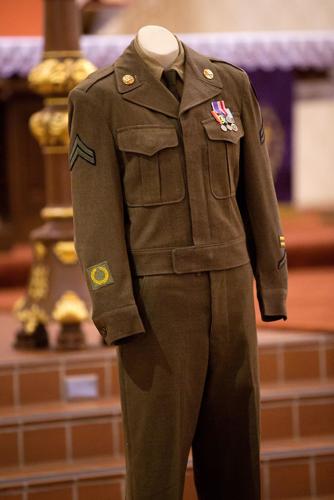After nearly 70 years listed as missing in action, Korean War veteran Army Cpl. Arthur Contreras Ramirez’s remains were laid to rest before family, friends and veterans on Thursday.
A funeral Mass was said at the downtown St. Augustine Cathedral — and a limited crowd was allowed under coronavirus protocol followed by the church.
The morning air was cool from recent rain, and Tucson Police Department motorcycle officers and American Legion Post 59 Riders escorted the black hearse carrying Ramirez’s silver coffin to his burial service at the Arizona Veterans Memorial Cemetery in Marana.
An Army honor guard fired a gun salute and taps was played before a cemetery crowd of about 50 — many of Ramirez’s relatives becoming emotional, especially when the American flag that was draped on his coffin was handed to his niece Josephine Ramirez Fulgham, who is in her 80s.
Ramirez, an Amphitheater High School student, left Tucson at 18 and traveled to Phoenix to enlist in the Army. He was a member of Baker Battery, 57th Field Artillery Battalion, 7th Infantry Division.
At age 19, he went missing in action against Chinese Communist Forces in Hagaru-ri, North Korea, near the Chosin Reservoir on Dec. 6, 1950, when enemy forces attacked his unit, according to U.S. Defense Department officials. His remains could not be recovered after the attack.
Ramirez was not among prisoners or remains returned to U.S. custody after the war, and the exact circumstances of his loss were unknown until 2018, officials said.
On July 27, 2018, following the summit between President Trump and North Korean leader Kim Jong Un, North Korea turned over 55 boxes of remains of American service members killed during the Korean War, officials said.
Some of the returned remains were recovered from an area where Ramirez’s unit had fought the Chinese Communist Forces on the eastern side of the Chosin Reservoir, according to records.
The remains arrived on Aug. 1, 2018, to a specialized unit of the Defense Department in Hawaii, and scientists using DNA previously provided by family members identified Ramirez in September 2019 from among these remains, officials said.
Armando Rubalcaba, 70, an Air Force veteran who served in the Vietnam War, is Ramirez’s nephew. He became emotional when aircraft flew a missing man formation over the cemetery. “I still remember the day I saw my Nana Angelita, Arthur’s mother, crying. I was about 4 and too young to understand, but in time I learned the reason why. Nana had just received notification from the Department of the Army that Arthur was classified MIA in 1950 and was presumed killed in action.”
Rubalcaba spoke about Ramirez’s service during extreme cold weather and under relentless heavy attacks by Chinese Communist Forces along the Chosin Reservoir. Frostbitten men dragged themselves across the ice until Marines spotted and rescued them, Rubalcaba learned in his research. For several days, survivors continued to arrive at the Marine Corps base at Hagaru-Ri. Arthur was among them at one point before he later went missing.
Rubalcaba recalled that Nana Angelita “held on to the hope that Arthur would come home after the Armistice was signed on July 27, 1953.” But he did not. “It was said that Nana held on to the thought that maybe, just maybe he had met a nice Korean girl and he didn’t want to leave her, clinging to the hope that he was still alive.”
The nephew closed with a poem: “I did my duty. I paid the supreme price. I pray you will remember my sacrifice. My life was short. I did my best. God, grant me peace in my eternal rest.”
“Welcome home Tio,” said Rubalcaba.
Photos: Funeral Mass for Korean War Veteran
Army Cpl. Arthur Contreras Ramirez
Updated
Members of the Fort Huachuca Select Honor Guard roll the casket for Korean War veteran Army Cpl. Arthur Contreras Ramirez towards St. Augustine Cathedral for a mass on March 19, 2020. Ramirez was 18 years old when he enlisted in 1949. At 19 years old he went missing in action. Ramirez was identified in 2019 after North Korea returned the remains of soldiers to the U.S. in 2018.
Arthur Contreras Ramirez
Updated
U.S. Army Cpl. Arthur Contreras Ramirez of Tucson, who fought at the Chosin Reservoir in the Korean War.
Army Cpl. Arthur Contreras Ramirez
Updated
Carol Jean Migliore bows her head during a mass for Korean War veteran Army Cpl. Arthur Contreras Ramirez at St. Augustine Cathedral on March 19, 2020. Ramirez was 18 years old when he enlisted in 1949. At 19 years old he went missing in action. Ramirez was identified in 2019 after North Korea returned the remains of soldiers to the U.S. in 2018.
Army Cpl. Arthur Contreras Ramirez
Updated
Family members and friends walk past members of the American Legion Post 59 legion riders into St. Augustine Cathedral for a mass for Korean War veteran Army Cpl. Arthur Contreras Ramirez on March 19, 2020. Ramirez was 18 years old when he enlisted in 1949. At 19 years old he went missing in action. Ramirez was identified in 2019 after North Korea returned the remains of soldiers to the U.S. in 2018.
Army Cpl. Arthur Contreras Ramirez
Updated
A member of the Fort Huachuca Select Honor Guard salutes the casket for Korean War veteran Army Cpl. Arthur Contreras Ramirez before it is rolled into St. Augustine Cathedral for a mass on March 19, 2020. Ramirez was 18 years old when he enlisted in 1949. At 19 years old he went missing in action. Ramirez was identified in 2019 after North Korea returned the remains of soldiers to the U.S. in 2018.
Army Cpl. Arthur Contreras Ramirez
Updated
Patricia Ramirez-Bielawski, seated, and others practice socal distancing during a mass for Korean War veteran Army Cpl. Arthur Contreras Ramirez at St. Augustine Cathedral on March 19, 2020. Ramirez was 18 years old when he enlisted in 1949. At 19 years old he went missing in action. Ramirez was identified in 2019 after North Korea returned the remains of soldiers to the U.S. in 2018.
Army Cpl. Arthur Contreras Ramirez
Updated
An army uniform, one that Army Cpl. Arthur Contreras Ramirez would have worn, is displayed during a mass for the Korean War veteran at St. Augustine Cathedral on March 19, 2020. Ramirez was 18 years old when he enlisted in 1949. At 19 years old he went missing in action. Ramirez was identified in 2019 after North Korea returned the remains of soldiers to the U.S. in 2018.
Army Cpl. Arthur Contreras Ramirez
Updated
Armando Rubal Caba reads a passage during a mass for Korean War veteran Army Cpl. Arthur Contreras Ramirez at St. Augustine Cathedral on March 19, 2020. Ramirez was 18 years old when he enlisted in 1949. At 19 years old he went missing in action. Ramirez was identified in 2019 after North Korea returned the remains of soldiers to the U.S. in 2018.
Army Cpl. Arthur Contreras Ramirez
Updated
An Amercian flag is placed back on the casket after a mass for Korean War veteran Army Cpl. Arthur Contreras Ramirez at St. Augustine Cathedral on March 19, 2020. Ramirez was 18 years old when he enlisted in 1949. At 19 years old he went missing in action. Ramirez was identified in 2019 after North Korea returned the remains of soldiers to the U.S. in 2018.







